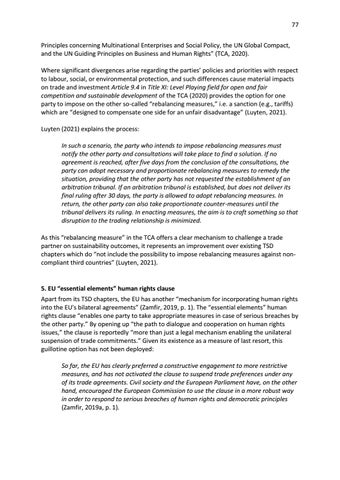77 Principles concerning Multinational Enterprises and Social Policy, the UN Global Compact, and the UN Guiding Principles on Business and Human Rights” (TCA, 2020). Where significant divergences arise regarding the parties’ policies and priorities with respect to labour, social, or environmental protection, and such differences cause material impacts on trade and investment Article 9.4 in Title XI: Level Playing field for open and fair competition and sustainable development of the TCA (2020) provides the option for one party to impose on the other so-called “rebalancing measures,” i.e. a sanction (e.g., tariffs) which are “designed to compensate one side for an unfair disadvantage” (Luyten, 2021). Luyten (2021) explains the process: In such a scenario, the party who intends to impose rebalancing measures must notify the other party and consultations will take place to find a solution. If no agreement is reached, after five days from the conclusion of the consultations, the party can adopt necessary and proportionate rebalancing measures to remedy the situation, providing that the other party has not requested the establishment of an arbitration tribunal. If an arbitration tribunal is established, but does not deliver its final ruling after 30 days, the party is allowed to adopt rebalancing measures. In return, the other party can also take proportionate counter-measures until the tribunal delivers its ruling. In enacting measures, the aim is to craft something so that disruption to the trading relationship is minimized. As this “rebalancing measure” in the TCA offers a clear mechanism to challenge a trade partner on sustainability outcomes, it represents an improvement over existing TSD chapters which do “not include the possibility to impose rebalancing measures against noncompliant third countries” (Luyten, 2021).
5. EU “essential elements” human rights clause Apart from its TSD chapters, the EU has another “mechanism for incorporating human rights into the EU's bilateral agreements” (Zamfir, 2019, p. 1). The “essential elements” human rights clause “enables one party to take appropriate measures in case of serious breaches by the other party.” By opening up “the path to dialogue and cooperation on human rights issues,” the clause is reportedly “more than just a legal mechanism enabling the unilateral suspension of trade commitments.” Given its existence as a measure of last resort, this guillotine option has not been deployed: So far, the EU has clearly preferred a constructive engagement to more restrictive measures, and has not activated the clause to suspend trade preferences under any of its trade agreements. Civil society and the European Parliament have, on the other hand, encouraged the European Commission to use the clause in a more robust way in order to respond to serious breaches of human rights and democratic principles (Zamfir, 2019a, p. 1).













